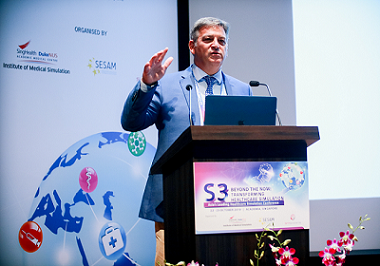Invention of a Novel, Realistic Ophthalmic Block Simulator for Ophthalmology Trainees
Introduction
Ophthalmology trainees learn to perform ophthalmic blocks by watching seniors, then attempting them directly on patients. This is stressful and exposes the patient to higher risks of complications. The aim of this study is to invent a novel peribulbar simulator that is realistic and anatomically accurate. Our secondary aim is to evaluate this simulator in improving the confidence and accuracy of peribulbar blocks given by ophthalmology residents.
Methods and results
We collaborated with Singapore General Hospital 3D Design and Printing centre to design a realistic and functional orbital structure. We also searched and tested out different materials to simulate different components of the orbit – periorbital tissue, eyeball, conjunctiva and facial tissue.
We conducted a supervised training workshop using this simulator on ophthalmology residents from Singapore National Eye Centre and administered questionnaires before and after the workshop. We evaluated (i) resident self-assessed confidence and competence, (ii) in the operating room, supervisor attending’s assessment of akinesia after block performed by resident, and their confidence and competence in the resident, (iii) accuracy of 5 peribulbar blocks performed on the simulator.
The bony orbit was 3D printed based on a real-life Asian orbit CT scan image series using transparent epoxy resin to allow for direct visualisation of the needle path. Different components of the model were made using readily available and easily replaceable materials as similar to the human orbit as possible. Facial skin was simulated using silicone, conjunctiva was simulated using Tegaderm and periorbital tissue was simulated using slime. The eyeball was simulated using a metal ball with some padding to simulate a normal eye – it can be replaced with different sized metal balls to simulate different axial lengths of the eye (e.g. in myopic eyes).
All residents who participated in this simulator training felt that this would help them avoid complications in performing a peribulbar block (n = 8). Based on a 10-point Likert score, residents ranked themselves more confident (7.57 to 8.57, p=0.018) and competent (7.71 to 8.43, p=0.047) (n=7) after the workshop. While consultants also found an improvement in akinesia after blocks given by residents, and felt that residents were more competent and felt more confident in their skills, these variables did not demonstrate a statistically significant difference. There was improved mean accuracy in blocks performed on the simulator after training with the simulator (4.17 to 4.83, n=12 p=0.054). There were no penetrating injuries on patients in our training group.
Discussion
This novel ophthalmic block simulator is realistic, anatomically accurate, simple, low cost, and provided direct visualisation of the needle within the orbit. Our pilot study also showed that this simulator is effective in helping trainees gain competence and confidence in performing blocks.
© 2025 SingHealth Group. All Rights Reserved.














